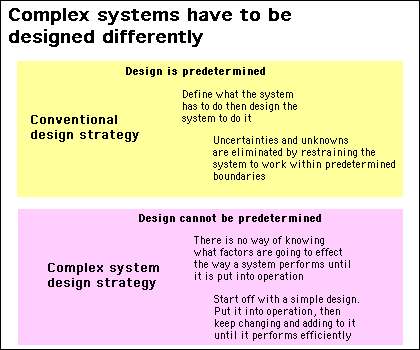

Controlling a complex dynamic system
The Web site is a part of a complex system
The technical aspects of Web site design are subservient to the far more powerful effects of unpredictable system dynamics.
A Web site is not complete in itself. It is only the visible part of a wider system that includes: visitors to a Web site; the people who make changes to the Web site; the people who choose the information that appears on the Web site; competition; search engines; the current stage of computer technology; the whole of the World Wide Web and the Internet. All these various factors have an influence on the functional success of a Web site.
It is a dynamic, complex system. It involve people and human behavior. All the components of the system interact and are interdependent. The actions of any one component can have a rippling effect on all the others. Such a system can behave unpredictably and chaotically.
The fundamental corner stones of business - logic, reason, prediction, planning and control - are impotent in the face of this complexity. The only way to influence the behavior of these complex situations is to use the methods found in natural systems. This requires an understanding of some of the concepts of chaos and complexity theory.
One definition of a complex system is "a system that is too complex to be understood". So, to talk about controlling a complex system might seem to be a paradox. How can you control a system that you cannot understand?
This was a problem until the advent of computers in the latter half of the twentieth century, when it became possible to model non-linear systems. This gave rise to "Chaos Theory", which provided a revolutionary new way to look at complexity. More importantly, it explained how nature controls complexity to produce organization through a process of evolution.
It has been famously remarked that "evolution has been around for so long, people think they understand it". The truth is that evolution was not understood before chaos theory introduced the idea of "strange attractors". If you don't understand chaos theory, you don't understand evolution.
It is through an understanding of chaos and strange attractors that we can incorporate biological strategies into information systems.
Blind design - the strategy of not knowing
You cannot design a stigmergic system in the same way as you can design conventional systems because you are dealing with complexity. By definition, you cannot design a complex system, so, a quite different approach is needed.
Instead of starting off with firm ideas as to how a user should use a system, you have to start without any preconceived ideas at all. In other words you assume you don't have any idea as to how a user will use the system. These two, quite different, approaches to design are summarized in the following diagram.

This may seem a crazy way to contemplate the design of a system, but the experience of human use of systems tells us that features and functions are often used in ways quite different from those intended by the designer. Sometimes, they are ignored altogether.
Even a complete system can be used in a way that was never originally envisaged. The classic case is the first spreadsheet (Visicalc). This was designed as a visual calculator. The freedom it gave people to use in a multitude of different, unrestrained ways, allowed it to be used as a sophisticated, system modelling tool. This played no small part in the initial success of Apple Computers.
By allowing people to use a system in unrestrained ways, you create what is technically known as a "dynamic complex system". This is a term used when a system is free to settle into its own characteristic mode of operation, without being forced to perform in a predetermined way.
Over the last twenty years, we have learned to understand these non-linear systems and discovered how to take advantage of their tendency to self-organize. This, as you will see, is the strategy behind the design of stigmergic systems.